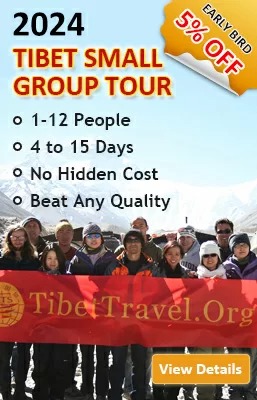
People and Customs in Lhokha
Lhokha area, richly endowed by nature, is the birthplace of Tibetan. The mythology that a male Monkey made love with a female Rock-demon as to give birth to the ancestors of plateau inhabitants makes Gongburi mountain a sacred place to honor their forefathers for the Tibetan.
Celebrated figures:
As a place of origin of culture, Lhokha region has been the home of lots of eminent scholars and artists.
The fifth Dalai Lama Luosangjiacuo, born in Qiongjie, composed a book Tibetan Kings and Rulings in which he gave a brief account of Tibetan history from the very beginning to 10 century B.C, when the king Gushi was in power. The book was written in an easy and fluent style with full and accurate historical facts. After that, the fifth Dalai Lama wrote other 30 works like New interpretation to Physiognomy, Teaching materials about Bodhi Daoci theory, Guidance to Dabeicidi theory.
Born in Menyu, Cuona, the sixth Dalai Lama Cangyangjiacuo was not only well-known for his talent but also for his wide-spread love poems in all Tibet. In addition, the eminent monk Milariba, who cultivated in the Lozhasanggaguoduo temple in the 11th century, compiled Songs on truth and played an important role in the spread of Buddhism. The book conveyed the profound meaning of Buddhism and was very easy to understand.
In the 16th century, the eminent monk Bawo.zulachenwa, abbot of the Luozhalalong Monastery, applied himself to historic study with great concentration and wrote books like Happy feast of Virtuous People. Now his books are necessary and important literatures for the study of Tibetan religious history.
In the first of 18th century, Duoga.cirenwangjie wrote a romantic poetic novel named Xunnumeida which occupies an important place in the Tibetan literature, when he held the post of leader in the ancestral temple.
Folk Songs and Dances
Guoxie
Guoxie is a transliteration in Tibetan, Guo meaning a circle, Xie a dance. Prevailing in rural area in Lhokha, Guoxie is a kind of song and dance with a long history, which people in the countryside are used to amusing themselves with. Most rural people, the old and young alike, could dance Guoxie a lot in such an environment.
Lyrics of Guoxie covers a wide range and falls into nine categories: on mountains, on sacred places, on hometown, on animals, on plants, on history and distinguished persons, on weather, on customs and conventions, and on love. Guoxie has both eulogistic songs and antiphonal songs. When it comes to eulogistic songs, all the participants will stay benign and solemn.
To dance Guoxie, one should march three steps and stamp one with hands waving from side to side, then step two forward and stamp one with hands swinging forth and back, then step twice and stamp twice with hands shaking up and down, next, march three steps with left leg lifted following lifting of right leg and stamp twice with both hands at right side and then swinging left-side, also back-step and turn with right hand flat overhead, while putting the palms and feet together and then separate, etc.
While dancing Guoxie, people will get together on a flat field in the village to make a circle with males one half and females the other, all participants hand in hand. Generally, one male participant will act as a Xieben( leading dancer). As the female participants singing and dancing, they only repeat what the males sung..
In addition to Guoxie, there are other dances like yak dance in Lhokha.






35 Comment ON "People and Customs in Lhokha"
Asked by Liliana Me** from Macau
plan a 7-8days trip for me and my boyfriend in April
Hi! I would like to plan a 7-8days trip for me and my boyfriend in April (3rd to 10th ideally) to Nepal, Tibet, and, if possible, Bhutan. Do you think it would be doable? Based on what I read, there are some places/things to do to consider: Nepal: Everest Base Camp trek and the Annapurna Circuit, ancient temples, sacred sites like Lumbini, Kathmandu, Tibet: The Potala Palace in Lhasa and the Jokhang Temple. eventually the holy Mount Kailash or the high-altitude plains. Bhutan: Thimphu, Paro, and the famous Tiger’s Nest Monastery. To take part in cultural traditions, yoga, meditation... Of course I am open to any recommendations you could make. For your reference, we are both based in Asia: him, in Bangkok and myself in Macau. Thank you so much for the information you could provide and, if possible, an estimated budget for your offer.
Asked by Ke** from Singapore
Cycling Tour to Mt Kailash
Hi , we are planning a Cycling Trip once Tibet opens for Tourism. The plan is we shall arrive to Kathmandu , travel to the border and enter via Kerung. Can you pls send a day to day Itinerary starting from Kerung - Lake Manasarovar - Darchen - Asthapath. We shall go around Kailash on foot and resume Cycling back to Kerung. We are a Group of 6-8 persons. Thanks Pls send ur reply to Kevin
Asked by Debo** from USA
Please can you tell me the prices and dates for the Tibet Luxury Tour.
Also, could you please provide a detailed itinerary - I want to see how many hours are spent on buses/vehicles. Thank you! Deborah
Asked by S** from HongKong
Tibet Tour from HK
May I know if holding Mainland Travel Permit for HK Residents. is it also need to get the visa permit to Tibet and what is the procedure if need to apply? Thank you
Asked by Na** from USA
Is Kailash Mansarovar Trip open for Indian Passport Holder?
Is it open for Indian Passport Holder?
Asked by A** from Singapore
Enquiry on private tour
We are planning a trip from Hong Kong to Tibet during the 12th to 21st of April. We want a private tour that covers all the scenic places as well as the EBC. Please advise an itinerary along with the cost breakdown. Thanks.
Asked by Na** from Canada
We would like to take the train from Xining to Lhasa
Asked by Gr** from Canada
The "Tibet Entry Permit" should be apply
Asked by Tam** from Singapore
Sightseeing Potala Palace
Asked by Ka** from Singapore
plan to travel to Mount Kailash